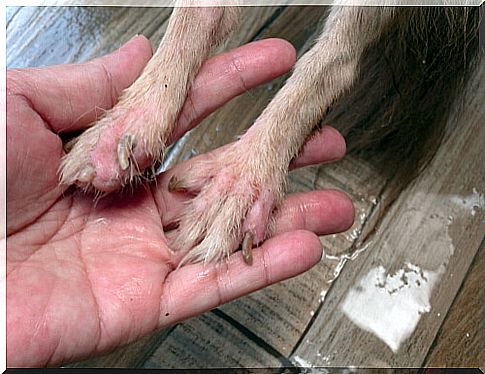Allergies In Dogs: How Frequent Are They?

Allergies in dogs are a fairly frequent reality given the multitude of substances capable of causing them. Knowing the most common and their potential symptoms is very useful to know how to address them.
In general, the term allergy refers to the overactivity or hypersensitivity of the immune system when in contact with certain substances.
The latter, called allergens, can be of a plant, animal or even inorganic origin. Once ingested, inhaled or absorbed through the skin, they will cause the characteristic signs of the inflammatory process.
Mainly responsible for this inflammation is a chemical called histamine. This is released when the allergen combines with the antibodies emitted by the immune system, causing the characteristic redness, swelling and itchiness.
Allergies in dogs usually appear after six months of age and, in addition to being a common condition, some can be inherited.
Most common canine allergies
As in humans, there are many canine allergies with their respective symptoms. However, it is convenient to take into account possible responses specific to each organism.
- Inhalant allergy or atopy. The main allergens are pollen, molds, fungi, and house mites. Although they are related to seasonality, some can occur permanently, especially those associated with dust or pollution. Itching on the face, ears, front legs or abdomen is quite common. The most serious cases can develop rhinitis, asthma, desquamation and alopecia.

- Food allergy. Although any ingredient can cause it, those of a protein nature, be it meat, milk, soy, eggs or gluten, are more common. In addition to the symptoms of inflammation, they can cause digestive and respiratory disorders. To diagnose them, normally, elimination diets are used, excluding certain products for two or three months.
- Sting allergy. They occur when the inflammatory response is exaggerated beyond the typical wheal. Some of the most common are those caused by spiders, bees, wasps, mosquitoes, fleas, and ticks. Characteristic symptoms are local swelling and, due to excessive scratching or licking of the animal to mitigate the itch, alopecia or secondary infections may occur.
Diagnosis and treatment of allergies in dogs
Diagnosing allergies in dogs can be quite complex, given the diversity of allergens and the overlap of allergies in some cases. Therefore, it is essential that the owners observe any symptoms of inflammation or other ‘spontaneous’ disorder. Veterinarians will use all of these signs, along with age, breed, and medical history to assess for a possible allergy.
The difficulty of diagnosis is even greater, especially in the case of food allergies, because blood and skin tests are often inconclusive.

By contrast, these types of allergies are the easiest to deal with because, normally, the exclusion of the ingredient in question leads to the disappearance of the symptoms.
In the case of atopias it is more complicated given the presence of the allergen in the environment. Its treatment depends on the duration and the exposure of the animal. Anti-inflammatory therapy based on corticosteroids or antihistamines is the fastest and most effective alternative. In addition, you can also opt for preventive vaccinations and, as a complementary measure, the use of hypoallergenic shampoos.
On the other hand, to improve the symptoms of excessive inflammation before a sting, oral or topical anti-inflammatory medications are the most common. In addition, the dog should be prevented from touching the affected area.
Although allergies in dogs are quite common, once diagnosed, they are relatively easy to control. For this, the perseverance of the owners in the meticulous care of the animal will be essential.









